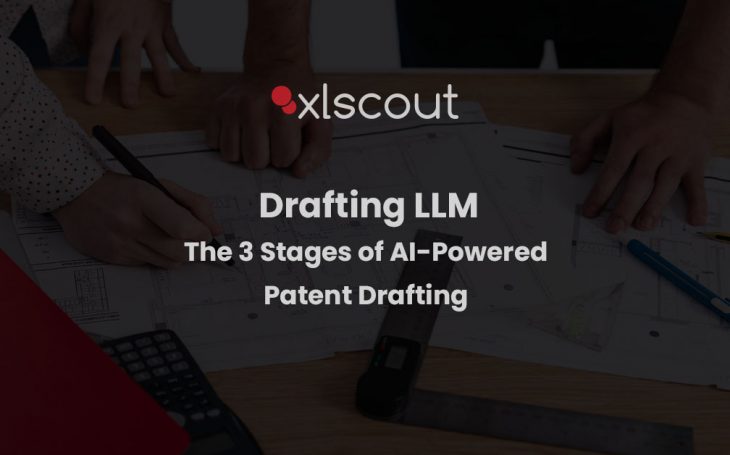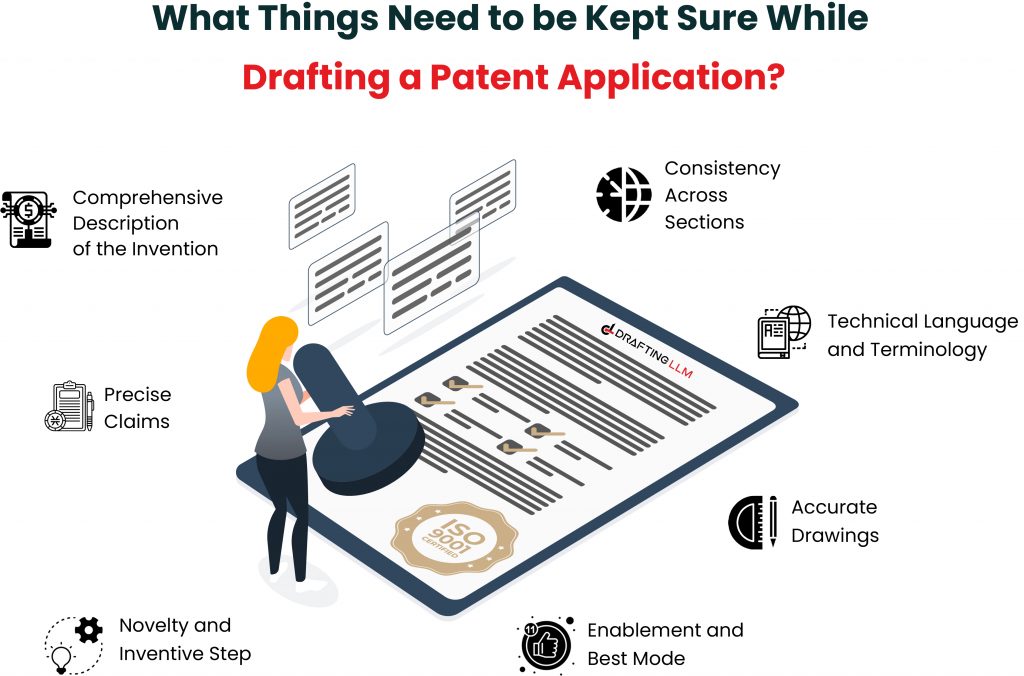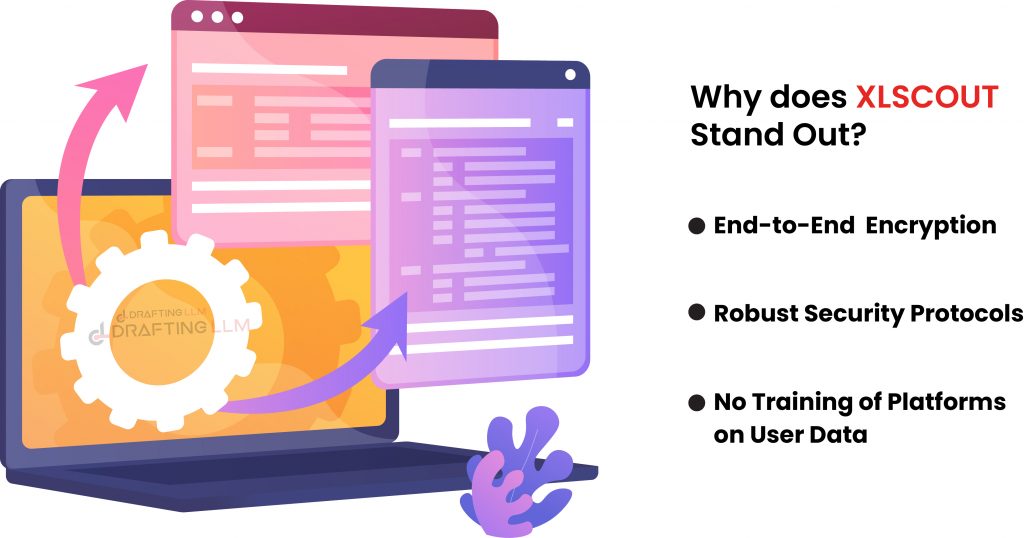
What Things Need to be Kept Sure While Drafting a Patent Application?
Drafting a patent application is a complex process that requires a keen understanding of both the invention itself and the legal framework surrounding intellectual property.
A well-crafted patent application serves as a crucial document in securing exclusive rights for an invention. To ensure the success of this process, certain key elements must be carefully considered during the drafting phase.

1. Comprehensive Description of the Invention
The core of a patent application is a thorough and clear description of the invention. This includes detailing how the invention works, its components, and any specific processes involved.
The description should be sufficiently detailed to enable a person skilled in the relevant field to replicate the invention based on the information provided.
2. Precise Claims
The claims section of a patent application defines the scope of the protection sought. It is important to draft claims that are clear, specific, and cover the novel aspects of the invention.
Broad claims are desirable to maximize protection, but they should not be overly broad to the extent of including prior art or being susceptible to invalidation.
3. Novelty and Inventive Step
For patentability, the novelty and non-obviousness of the invention is of utmost importance. Careful consideration of prior art is essential to highlight the unique aspects of the invention.
The patent drafter must establish why the invention is different from existing technologies and how it involves an inventive step that wouldn’t be obvious to someone skilled in the field.
4. Enablement and Best Mode
Enablement refers to providing enough information in the application to enable a person skilled in the field to make and use the invention without undue experimentation.
Additionally, disclosing the best mode of carrying out the invention is a legal requirement. Failure to meet these criteria can lead to challenges during the patent examination process.
5. Accurate Drawings
Where applicable, visual representations of the invention through drawings or diagrams should be included.
Clear and accurate drawings can significantly enhance the understanding of the invention and support the written description and claims.
6. Technical Language and Terminology
Precision in language is crucial. The use of clear and concise technical terms helps in conveying the exact nature of the invention.
Avoiding ambiguous language ensures that the patent application is not open to interpretation, reducing the risk of potential disputes.
7. Consistency Across Sections
Maintaining consistency across the various sections of the patent application is vital. The description, claims, and drawings should align seamlessly to present a unified and coherent portrayal of the invention.
A Focus on Confidentiality and Safe Data Storage Practices

Safeguarding confidential information and data storage security have become a paramount concern for individuals and businesses alike.
The Pitfalls of Free Online Platforms
Many individuals are tempted to use free online platforms to document and share their ideas or intellectual property. However, this convenience comes at a cost, as these platforms often lack robust security measures.
Free platforms may have vulnerabilities that expose your sensitive information to unauthorized access, leading to potential data breaches and intellectual property theft.
Moreover, the terms of service on free platforms might grant the platform certain rights over the content you upload. This can result in a loss of control over your intellectual property, compromising its confidentiality and potentially undermining your ownership rights.
Why does XLSCOUT Stand Out?

XLSCOUT acknowledges the critical importance of confidentiality of intellectual property and data storage. To address these concerns, XLSCOUT incorporates advanced safety and privacy features to ensure that your information remains secure.
1. End-to-End Encryption
One of the key security measures offered by XLSCOUT is end-to-end encryption. This means that your data is encrypted from the moment it is entered into the platform until it reaches its intended recipient.
2. No Training of Platforms on User Data
XLSCOUT distinguishes itself by adopting a privacy-centric approach. Unlike some platforms that may use user data to train algorithms or improve their services, XLSCOUT upholds a strict policy of not training its platforms on user data.
This ensures that your sensitive information is not utilized for purposes beyond its intended use, enhancing user confidence in the platform’s commitment to privacy.
3. Robust Security Protocols
XLSCOUT employs state-of-the-art security protocols to protect user data from external threats. This includes measures such as secure server infrastructure, regular security audits, and adherence to industry best practices. These efforts collectively contribute to creating a safe and trusted environment for users to store and manage their intellectual property.
Confidentiality and safe data storage are non-negotiable aspects of intellectual property management. While the convenience of free online platforms may be tempting, the associated risks make them an unsuitable choice for safeguarding sensitive information.
XLSCOUT, on the other hand, prioritizes user privacy through robust security features.
Stage 1: Automation and Language – Unleashing AI’s Power in Patent Drafting
This marks a transformative leap with the integration of automation and advanced language processing facilitated by artificial intelligence (AI).
1. Generating a Description from the Claims
The traditional process of patent drafting often involved laborious efforts to translate detailed claims into a comprehensive and articulate description.
With the advent of AI, this translation process has undergone a revolutionary shift. AI-powered tools can analyze patent claims and automatically generate a detailed description, capturing the essence of the invention with remarkable accuracy.
This innovation not only expedites the drafting process but also minimizes the risk of human error in translating technical language into a coherent narrative.
By understanding the nuances of the claims, AI ensures that the resulting description aligns seamlessly with the inventive concept, laying a robust foundation for the patent application.
2. Generating Standard Figures
Visual representation is pivotal in patent applications, providing clarity and insight into the intricate details of an invention.
AI extends its capabilities to automate the generation of standard figures, including flowcharts and block diagrams. This functionality is invaluable, especially in fields where complex processes or algorithms are central to the invention.
AI’s prowess in interpreting the technical language and translating it into visual representations ensures consistency and precision in the figures.
This saves a considerable amount of time and also enhances the overall quality of the patent application, offering examiners and stakeholders a clearer understanding.
3. Drafting Standard Boilerplate Language
The inclusion of standardized language in patent applications is a crucial yet time-consuming aspect of the drafting process.
AI addresses this challenge by automating the drafting of standard boilerplate language. From background sections to legal disclaimers, AI-powered platforms can generate templated language that adheres to regulatory requirements and industry standards.
Stage 2: Technical Depth and Domain Mastery
This stage harnesses the capabilities of artificial intelligence (AI) to delve into the intricate details of the invention, ensuring a nuanced and comprehensive representation that aligns with the specificities of the technology involved.
1. In-Depth Technical Analysis
At the heart of Stage 2 is the AI-driven capability to conduct in-depth technical analysis of the invention. AI tools, equipped with advanced algorithms, can parse through vast amounts of technical literature, research papers, and databases to identify existing knowledge and contextualize the uniqueness of the proposed invention.
This level of analysis goes beyond the surface, offering patent drafters a nuanced understanding of the technological landscape and aiding in the formulation of claims with enhanced clarity and distinctiveness.
2. Domain-Specific Language Processing
AI’s language processing abilities extend to domain-specific nuances, a critical feature in industries with highly specialized vocabularies. AI can comprehend and deploy technical jargon and industry-specific language, ensuring that the patent application reflects the precision and expertise characteristic of the field.
This capability streamlines communication between patent drafters and experts in the domain, facilitating a more accurate and comprehensive representation of the invention.
3. Intelligent Claim Expansion
AI excels at intelligent claim expansion. By analyzing existing patent databases and technical literature, AI identifies potential extensions and variations of the original claims, enriching the scope of protection sought.
This proactive approach not only strengthens the patent but also minimizes the risk of overlooking alternative embodiments that could be crucial to the overall protection of the invention.
4. Collaboration with Domain Experts
AI also acts as a powerful collaborator, enhancing the synergy between technology and human expertise. It assists patent drafters in collaborating with domain experts by providing comprehensive technical insights and facilitating a more nuanced dialogue.
This collaborative approach ensures that the patent application aligns seamlessly with the intricacies of the technology, maximizing the chances of successful prosecution and enforcement.
Stage 3: Merging Legal Expertise and Creative Guidance
Stage 3 emerges as the pinnacle where legal expertise converges with creative guidance, shaping the patent application into a legally sound and strategically crafted document.
In this stage, AI takes on the role of a legal collaborator, ensuring the alignment of the patent with legal standards while infusing creative insights into its formulation.
1. Legal Precision in Claim Language
One of the key contributions of AI lies in enhancing the legal precision of claim language. Legal experts often grapple with the challenge of formulating claims that not only encompass the invention’s breadth but also withstand legal scrutiny.
AI analyzes vast legal databases and patent precedents, refining the language of claims to align with legal standards. This complex approach minimizes ambiguities and fortifies the patent against potential challenges during examination and litigation.
2. Compliance with Jurisdictional Requirements
AI is programmed to ensure compliance with jurisdiction-specific requirements. Whether it’s adhering to specific patentability criteria or incorporating nuances of local patent laws, AI’s legal expertise streamlines the drafting process, mitigating the risk of errors that may arise from jurisdictional variations.
3. Creative Guidance for Strategic Patenting
While legal precision is imperative, creativity is equally vital in patent drafting. AI offers creative guidance by analyzing the competitive landscape and identifying potential avenues for strategic patenting.
By understanding the broader context of the industry and technological trends, AI assists patent drafters in formulating claims and descriptions that not only secure protection for the current invention but also strategically position it in the market.
4. Dynamic Legal Updates and Adaptability
Legal landscapes are dynamic, and AI adapts to changing regulations and legal precedents. By continuously monitoring legal developments, AI ensures that patent applications remain aligned with the latest legal standards, offering long-term protection in the ever-evolving legal environment.
Will AI replace patent attorneys?
It has become evident that while AI is poised to revolutionize certain aspects of patent drafting, it is unlikely to replace the nuanced expertise and creativity that human patent attorneys bring to the table.
The Role of AI in Patent Drafting
AI has demonstrated remarkable capabilities in automating routine tasks, processing vast amounts of data, and even generating complex technical and legal content.
In the context of patent drafting, AI has been deployed across the three stages of automation and language, technical depth and domain expertise, and legal expertise and creative guidance.
In the first stage, AI streamlines the drafting process by generating descriptions from claims, creating standard figures, and even drafting boilerplate language. It acts as a powerful assistant, significantly reducing the time and effort required for these initial tasks.
In the second stage, AI delves into technical intricacies, offering in-depth analyses, domain-specific language processing, and intelligent claim expansion. This enhances the precision of the patent application by leveraging vast databases and understanding the nuances of specific industries.
In the third stage, AI contributes legal expertise by ensuring compliance with jurisdictional requirements, refining claim language for legal precision, and even providing creative guidance for strategic patenting.
The Powerhouse Platform: Integrating All Three Stages
A platform that leverages LLMs and Generative AI, and seamlessly integrates all three stages of AI patent drafting emerges as a powerhouse tool for patent attorneys.
Such a model, when applied effectively, would handle routine tasks, improve the overall writing quality of patent applications, and add both technical depth and legal acumen.
The integration of these capabilities streamlines the drafting process, offering efficiency gains and ensuring a more robust and comprehensive representation of inventions.
AI as a Complement, Not a Replacement
While AI presents a transformative force in patent drafting, it is crucial to emphasize that it is not positioned to replace patent attorneys. Instead, AI acts as a complementary tool, an assistant that augments the capabilities of human professionals.
Human Expertise: The Irreplaceable Element
Human patent attorneys bring a unique set of skills to the table that goes beyond the capabilities of AI. The creative insight, strategic thinking, and nuanced understanding of legal nuances are elements deeply embedded in human expertise.
Crafting a persuasive argument, understanding the broader context of a technology’s evolution, and adapting to dynamic legal landscapes are facets of legal practice where human intuition and experience play a crucial role.
Moreover, the interpersonal aspects of legal practice, such as client interactions, negotiations, and courtroom representation, demand a level of emotional intelligence and understanding that AI cannot replicate.
Human patent attorneys navigate the complexities of client relationships, interpret subtle cues, and provide personalized legal counsel, contributing to the holistic practice of law.
Ethical Considerations and Decision-Making
The ethical dimension of legal practice is another critical area where human involvement is indispensable. Decision-making in legal matters often involves a nuanced understanding of ethical implications, cultural contexts, and societal values.
While AI can process data and identify patterns, it lacks the moral reasoning and ethical judgment inherent in human decision-making.
The Future of Legal Practice: A Harmonious Integration
As we ponder the future of legal practice in the era of AI, it becomes evident that the most promising trajectory is one of harmonious integration.
The collaboration between AI and human patent attorneys holds the potential to revolutionize the efficiency, accuracy, and scope of legal services.
By leveraging AI’s computational power for data processing, legal analysis, and document generation, patent attorneys can focus on higher-order tasks that require creativity, critical thinking, and emotional intelligence.
While AI is reshaping the process of patent drafting, its role is that of a powerful assistant rather than a replacement for human patent attorneys. The synergy between AI and human expertise stands as a testament to the evolving nature of legal practice, where technology enhances the capabilities of professionals, but the essence of legal reasoning and advocacy remains distinctly human.
As the legal profession embraces the opportunities presented by AI, it is poised to evolve into a more dynamic, efficient, and innovative domain, with human professionals at the helm, steering the course of justice and intellectual property protection.
Automated Patent Drafting with XLSCOUT’s Drafting LLM
Automated Patent Drafting: XLSCOUT introduces a groundbreaking solution that transcends traditional approaches to patent drafting.
Drafting LLM—an innovative platform that automates and elevates the patent drafting experience through the seamless integration of Large Language Models (LLMs) and Generative AI. This transformative technology not only streamlines the drafting process but fundamentally reshapes the landscape of intellectual property protection.
LLMs & Generative AI empower Drafting LLM to interpret and process complex inventions with remarkable accuracy, ensuring that the resulting patent documents are not only thorough but also adhere to the stringent standards set by patent offices from various jurisdictions.
Moreover, the platform’s intuitive interface and user-friendly design democratize the patent drafting process, making it accessible to a broader audience. Inventors, irrespective of their technical or legal expertise, can leverage the power of AI to articulate their ideas with precision and clarity.
XLSCOUT’s AI patent drafting module, Drafting LLM emerges as a trailblazing solution that not only automates patent drafting but redefines the very essence of innovation protection. By combining these latest AI technologies, LLMs and Generative AI, XLSCOUT empowers inventors and legal professionals to navigate the intricacies of patent applications with unprecedented efficiency, accuracy, and security.
Automated Patent Drafting Benefits with Drafting LLM
1. Speed and Efficiency
Drafting LLM significantly accelerates the patent application process. By automating the drafting phase, which traditionally consumes a considerable amount of time, users can generate high-quality patent drafts within minutes. This newfound speed not only enhances productivity but also allows innovators to stake their claims in the fiercely competitive intellectual property landscape promptly.
2. Precision and Accuracy
The precision offered by Drafting LLM is unparalleled. AI-driven algorithms meticulously analyze the intricate details of patent language, ensuring that the generated drafts adhere to the highest standards of accuracy. This eliminates the risk of errors commonly associated with manual drafting, providing users with a level of confidence in the quality of their patent applications.
3. Comprehensive Drafting Capabilities
Drafting LLM sets itself apart by offering a holistic approach to patent application generation. Beyond just the body of the application, the platform excels in crafting detailed claims, abstracts, background sections, summaries, and descriptions.
Moreover, it extends its capabilities to include the generation of intricate drawings such as flowcharts and block diagrams. This all-encompassing drafting functionality ensures that users can produce comprehensive and well-rounded patent applications effortlessly, covering every aspect required for a successful submission.
4. Adaptability and Customization
Drafting LLM is not a one-size-fits-all solution. Recognizing the diverse needs of innovators across industries, the platform offers a high degree of adaptability and customization. Users can tailor the generated drafts to suit specific requirements, ensuring that the resulting patent applications align seamlessly with their unique inventions and innovations.
5. Strategic Alignment with Legal Standards
Staying abreast of evolving legal standards is a challenge in the dynamic world of patents. Drafting LLM alleviates this burden by strategically aligning drafted applications with the latest legal standards. This proactive approach ensures that patent applications not only meet current requirements but also anticipate and incorporate future legal considerations.
6. Fine-Tuning Capabilities: Modify Language and Terminology for Different Jurisdictions
Recognizing the global nature of intellectual property protection, Drafting LLM empowers users with fine-tuning capabilities. Innovators often need to navigate different legal jurisdictions, each with its nuances and specific language requirements.
With Drafting LLM, users can seamlessly modify the language and terminology of their patent drafts to align with the standards and preferences of diverse jurisdictions. This adaptability ensures that patent applications not only meet the criteria of the user’s home jurisdiction but can also be tailored to comply with the specific requirements of international patent offices, enhancing the global relevance and applicability of the drafted applications.

